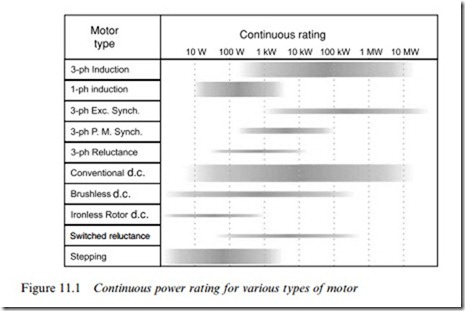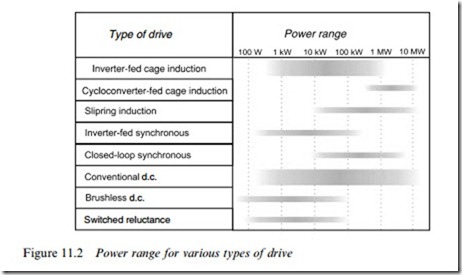POWER RANGE FOR MOTORS AND DRIVES
The diagrams (Figures 11.1 and 11.2) give a broad indication of the power range for the most common types of motor and drive. Because
the power scales are logarithmic it would be easy to miss the exception- ally wide power range of some types of motor: induction and d.c. motors, for example, extend from watts to megawatts, an astonishing range that few other inventions can match.
The width of the bands is intended to give some idea of relative importance, while the shading reflects the fact that there is no sharp cut-off at the extremities of the range. We should also bear in mind that we are talking here about the continuously rated maximum power at the
normal base speed, and as we have seen most motors will be able to exceed this for short periods, and also to run faster than base speed, provided that reduced torque is acceptable.
Maximum speed and speed range
We saw in Chapter 1 that as a general rule, for a given power the higher the base speed the smaller the motor. In practice, there are only a few applications where motors with base speeds below a few hundred rev/ min are attractive, and it is usually best to obtain low speeds by means of the appropriate mechanical speed reduction.
Speeds over 10 000 rev/min are also unusual except in small universal motors and special-purpose inverter-fed motors. The majority of medium-size motors have base speeds between 1500 and 3000 rev/min. Base speeds in this range are attractive as far as motor design is concerned, because good power/weight ratios are obtained, and are also satisfactory as far as any mechanical transmission is concerned.
In controlled-speed applications, the range over which the steady- state speed must be controlled, and the accuracy of the speed holding, are significant factors in the selection process. In general, the wider the speed range, the more expensive the drive: a range of 10:1 would be unexceptional, whereas 100:1 would be demanding. Figures for accuracy of speed holding can sometimes cause confusion, as they are usually given as a percentage of the base speed. Hence with a drive claiming a decent speed holding accuracy of 0.2% and a base speed of 2000 rev/ min, the user can expect the actual speed to be between 1996 and 2004 rev/min when the speed reference is 2000 rev/min. But if the speed reference is set for 100 rev/min, the actual speed can be anywhere between 96 and 104 rev/min, and still be within the specification.
For constant torque loads, which require operation at all speeds, the inverter-fed induction motor, the d.c. drive and any of the self-synchro- nous drives are possibilities, but only the d.c. drive would automatically come with a force-ventilated motor capable of continuous operation with full torque at low speeds.
Fan-type loads (see below) with a wide operating speed range are a somewhat easier proposition because the torque is low at low speeds. In the medium and low power ranges the inverter-fed induction motor (using a standard motor) is satisfactory, and will probably be cheaper than the d.c. drive. For restricted speed ranges (say from base speed down to 75%) and particularly with fan-type loads where precision speed control is unnecessary, the simple voltage-controlled induction motor is likely to be the cheapest solution.

